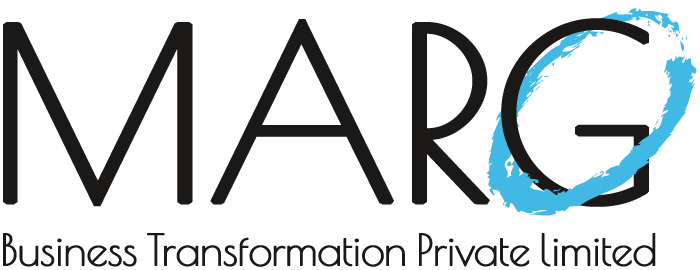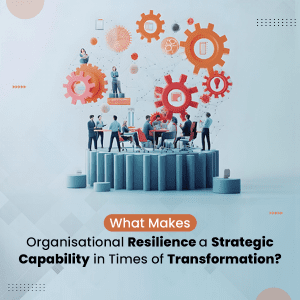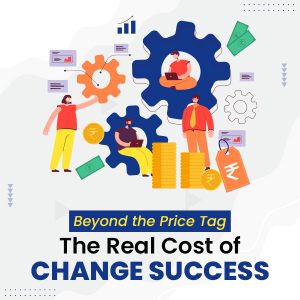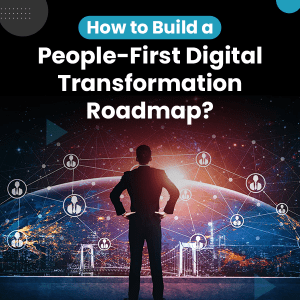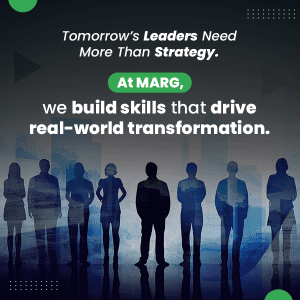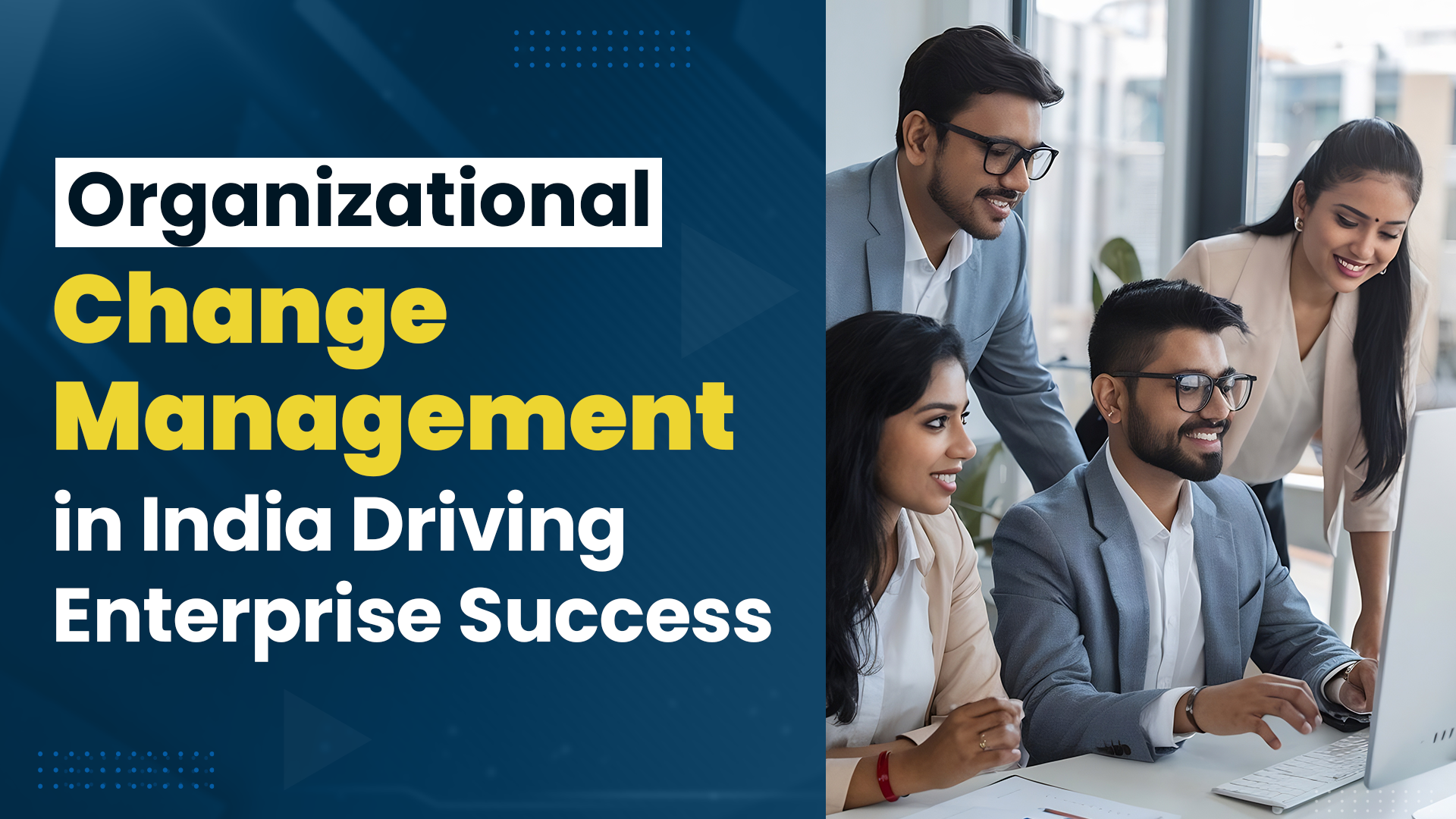
Introduction
India is transforming at a scale and speed never seen before. From large-scale digitization and automation to the rise of Global Capability Centres (GCCs), enterprises are reimagining how they operate and deliver value. Yet, while technology drives possibility, adoption depends on people. Global research shows that 70% of change initiatives fail because of the people side of change – resistance, lack of sponsorship, or poor communication – not because of flawed technical execution. This reality is shaping the way organizations in India invest in the disciplined change approach.
Key-Points –
· 70% of change initiatives fail due to people-side challenges.
. India’s enterprises need structured OCM to manage digital transformation, GCC growth, and cultural complexity.
. At Marg, the ADKAR® Model and 3-Phase Process are the leading OCM frameworks in India.
. Organizational Change Management Certification is in high demand for building internal capability.
. Leadership sponsorship is the #1 success factor for sustainable change.
As Prosci’s authorised affiliate in India since 2016, Marg Business Transformation has witnessed first-hand how companies are embedding structured approaches to navigate disruption. This blog explores the state of Organizational Change Management in India, the frameworks and certifications that matter, and practical insights into what works for enterprises leading transformation.
What Is Organizational Change Management?
Organizational Change Management (OCM) is the structured discipline that helps individuals, teams, and organisations transition from a current state to a desired future state. It focuses on the people side of change – equipping employees to adopt, embrace, and sustain new ways of working.
Without OCM, even the most innovative strategies or cutting-edge technologies risk underperformance because employees may resist or fail to adapt. With OCM, leaders can unlock higher adoption, smoother transitions, and stronger return on investment.
At its core, OCM is about bridging the gap between business intent and employee adoption.
What Causes Organizational Change?
Change rarely happens in isolation – it is driven by external forces and internal ambitions. In India’s business context, the main triggers include:
· Digital Transformation & Automation – From AI-driven analytics to cloud adoption, technology continues to redefine industries.
· Globalisation & GCC Expansion – India is a hub for multinational capability centres, requiring alignment across diverse geographies and cultures.
· Market & Regulatory Shifts – Evolving compliance standards, ESG expectations, and economic reforms push organisations to adapt quickly.
· Workforce Dynamics – Generational shifts, hybrid working models, and employee expectations for flexibility require cultural change.
· Competitive Pressures – Organisations that fail to innovate risk losing ground to faster, more agile competitors.
Understanding these drivers is the first step. But recognising that employees are at the centre of every change is what ensures success.
The Value of Organizational Change Management
If change is inevitable, why does OCM matter? The answer lies in impact and outcomes.
· Improved Project ROI – Research consistently shows that projects with excellent change management are 6–7x more likely to meet or exceed objectives.
· Faster Adoption – Structured OCM reduces resistance and accelerates the time it takes for employees to embrace change.
· Employee Engagement – Employees feel included, supported, and empowered when change is managed transparently.
· Reduced Risk – Anticipating resistance and preparing leaders prevents costly implementation failures.
· Sustained Success – Change doesn’t stop at launch; OCM ensures behaviours stick long after go-live.
For Indian enterprises navigating large-scale digital and cultural transformations, OCM is no longer optional – it is a competitive advantage.
The Growing Need for Organizational Change Management in India
Five forces are driving Indian enterprises’ urgency for structured OCM: ·
. Digital Transformation & AI: Companies are modernizing ERP systems, automating supply chains, and embedding AI into decision-making. But adoption remains uneven without addressing employee concerns.
. Global Trade Shifts: According to McKinsey, India could capture US $0.8–1.2 trillion in value by 2030 from shifting trade flows, with manufacturing’s GDP share expected to rise from 16% to 25%.
. GCC Expansion: India’s ~1,700 GCCs today employ nearly 2 million professionals. By 2030, this will expand to 2,200+ centres, generating US $105 billion in revenue.
· Regulatory Shifts: Compliance in industries like BFSI, pharma, and healthcare demands agility and structured adaptability.
· Demographic Complexity: Multi-generational workforces – with Gen Z digital natives working alongside Gen X leaders – require tailored adoption strategies.
The implication is clear: technology investments alone cannot deliver outcomes. Enterprises need structured Organizational Change Management in India to build change readiness, reduce resistance, and enable sustainable results.
Proven Foundations of Organizational Change Management in India
Marg’s change management journey in India, is anchored by globally recognised frameworks, providing a proven foundation for Organizational Change Management. Which includes:
The ADKAR® Model
This Model breaks successful change down into five building blocks:
1. Awareness – of why change is needed.
2. Desire – to participate and engage in change.
3. Knowledge – of how to change.
4. Ability – to implement required skills and behaviours.
5. Reinforcement – to sustain the change over time.
This simple yet powerful model enables leaders to diagnose adoption barriers and create targeted strategies. In India, ADKAR helps enterprises bridge linguistic, cultural, and hierarchical diversity by offering a common language of change.
Prosci’s 3-Phase Process
Beyond individual adoption, Prosci also provides an enterprise-level roadmap:
1. Prepare Approach – defining success, outcomes, and strategy.
2. Manage Change – activating plans, measuring adoption, enabling stakeholders.
3. Sustain Outcomes – embedding reinforcement and capturing lessons learned.
Together, ADKAR and the 3-Phase Process ensure that both individuals and organisations succeed during transformation. This dual focus is why Prosci methodologies have become the gold standard for Organizational Change Management Certification worldwide.
Why Organizational Change Management Certification Matters in India
Although OCM is gaining momentum, its maturity across India is uneven.
· Leading Industries: BFSI and IT services are more advanced in embedding OCM practices, while manufacturing and infrastructure are catching up.
. GCCs as Innovation Hubs: With revenues projected to cross US $99–105 billion by 2030, GCCs are embedding OCM to accelerate adoption of AI, cloud, and digital platforms.
· Leadership Awareness: Many senior leaders acknowledge OCM’s importance but still underestimate their sponsorship role. Prosci’s research consistently finds that active and visible sponsorship is the #1 success factor for change.
· Execution Gaps: While organisations invest in communication plans, they often lack tools for measuring readiness or addressing resistance at the individual level.
Top barriers include employee resistance (68%), lack of sponsorship (45%), weak communication (39%), and cultural mismatch (32%) (Gartner, 2024).
As Indian enterprises scale transformation, structured Organizational Change Management in India is moving from a support activity to a core capability.
Driving ROI with Organizational Change Management Certification
Certification is no longer a nice-to-have. As transformations multiply, enterprises require professionals who can bring structure, credibility, and proven methodology to their programs.
Key benefits of Organizational Change Management Certification:
· Proven Methodology: Certification ensures practitioners apply Prosci’s ADKAR® Model and 3-Phase Process.
· Career Differentiation: For CXOs, Digital Transformation Leaders, and project leaders, certification creates a competitive advantage.
· Higher Adoption Rates: Prosci research shows projects with dedicated OCM achieve up to 6x higher adoption and ROI.
· Enterprise Impact: Organisations with certified change practitioners build internal capability instead of relying solely on external consultants.
In India, demand for certified practitioners is rising, especially in GCCs, BFSI, and IT services. By investing in Organizational Change Management Certification, professionals not only advance their careers but also strengthen their organisation’s ability to manage disruption.
Leadership as the Catalyst of Change
Even with the best frameworks, change fails without leadership commitment.
In India’s hierarchical work culture, employees often look to leaders before embracing new behaviours. Effective change leaders must:
· Be visible and active throughout the change lifecycle.
. Consistently communicate the “why” of change.
. Empower middle managers as change coaches.
. Reinforce positive behaviours to sustain adoption.
Research confirms that sponsorship is the #1 predictor of change success. Leaders who combine certification with skills like empathy, resilience, and trust-building can transform not only processes but also culture.
What Works in India: Best Practices
Drawing from Prosci research and Marg’s experience in the Indian market, here are best practices that drive OCM success:
· Localised Communication: Adapt messages across languages and demographics for impact.
. Change Networks: Engage champions at every level to reduce resistance.
. Data-Driven Readiness: Use structured assessments to identify adoption hotspots.
. Leveraging GCC Scale: GCCs, expected to employ 2.8 million people by 2030, are incubating best practices in enterprise change.
Example: A leading Indian manufacturer implementing a new ERP system used ADKAR assessments across 3,000 employees, identifying “Desire” as the weakest link. By addressing this through leadership workshops and targeted communication, they accelerated adoption rates significantly.
Challenges Faced by Indian Organizations During Transformation
Even with ambitious strategies and strong investments, Indian enterprises often face hurdles that go beyond technology. Global research confirms that the people side of change is the biggest differentiator, and this is especially true in the Indian context.
Some of the most common challenges include:
· Resistance from leadership or legacy processes – Senior leaders may hesitate to move away from established practices. This lack of visible sponsorship creates bottlenecks in adoption.
· Communication breakdown – Messages about change often fail to cascade clearly through multi-layered organisations, leading to confusion or misalignment.
· Lack of structured change planning – Many organisations still treat change as a project add-on rather than applying a structured methodology like the ADKAR® Model. Without structured planning, resistance builds and ROI decreases.
As the authorised affiliate for the ADKAR® framework in India since 2016, Marg Business Transformation has consistently seen that overcoming these barriers requires both a research-backed methodology and contextual sensitivity to India’s unique business culture. By combining proven frameworks with local insights, Marg helps organisations reduce resistance, improve communication, and build change readiness.
How India’s Leading Companies Are Getting It Right
Forward-thinking enterprises in India are proving that structured change management delivers measurable results.
For Instance –
A leading BFSI enterprise was rolling out a large-scale digital platform. Adoption challenges quickly emerged – frontline staff were unsure of new processes, while middle managers struggled with resistance.
By applying the ADKAR® Model through target-based awareness campaigns, and reinforcement strategies, the organisation achieved:
· Faster adoption across organisations.
. Significant reduction in resistance within six months.
. A cultural shift towards embracing digital-first practices.
Do You Need a Certification to Lead Change in India?
Not every change effort requires formal certification. Experienced leaders can often guide small-scale transitions by applying lessons learned from the past. However, for large, enterprise-wide transformations, a structured and research-backed approach is essential.
This is where Organizational Change Management Certification becomes valuable. The Prosci Certified Change Practitioner program equips leaders and practitioners with a proven methodology, practical tools, and the credibility to drive adoption across functions.
In India, demand for certified practitioners is growing as organisations seek professionals who can lead transformations with confidence. While experience matters, certification in change
management in India is increasingly seen as the differentiator between ad-hoc efforts and scalable success.
FAQs
Q1. What is the best change management certification in India?
The Prosci Change Management Certification Program, delivered in India through Marg Business Transformation, is the most recognised and research-backed certification.
Q2. How do Indian companies manage organizational change?
Indian companies use structured methodologies like ADKAR® Model, supported by leadership sponsorship and change networks, to reduce resistance and accelerate adoption.
Q3. Is ADKAR used in India?
Yes. The ADKAR® Model is widely applied by enterprises in India because of its simplicity and ability to address the people side of change in diverse, multi-generational workforces.
Q4. What is the cost of change management certification in India?
While pricing may vary, Marg Business Transformation delivers Prosci’s globally recognised certification programs in India. For exact details, professionals are encouraged to contact Marg directly.
Q5. What industries in India benefit most from Organizational Change Management?
Industries like BFSI, IT services, GCCs, and manufacturing are seeing the greatest adoption of structured OCM practices.
Q6. How is Organizational Change Management different from Project Management?
Project Management focuses on delivering technical outcomes, while OCM ensures people adopt and sustain the change. Both must work together for success.
Q7. How long does it take to see results from Organizational Change Management?
While timelines vary, structured OCM often accelerates adoption within months, especially when supported by strong leadership sponsorship.
The Future of OCM in India
The next decade will see OCM evolve from a project-level enabler to a strategic driver.
· AI as a Change Driver: With India recognised as a leader in responsible AI maturity, OCM will be critical in ensuring ethical and sustainable adoption.
· Formal OCM Offices: Gartner predicts that by 2026, 60% of large enterprises will establish a dedicated OCM office to support transformation.
· Talent Demand: Certified change managers will be in high demand as enterprises seek to institutionalise internal OCM capability.
· Cultural Transformation: Indian organisations will increasingly use OCM not just for technology adoption but to drive culture change toward agility and innovation.
Conclusion
The success of India’s transformation story will not be defined by technology alone, but by how effectively enterprises manage the people side of change. Without structured change practices, initiatives risk becoming another statistic in the global failure rate.
By adopting the ADKAR® Model, applying the 3-Phase Process, and investing in Organizational Change Management Certification, Indian enterprises can dramatically improve change outcomes.
At Marg Business Transformation, as Prosci’s authorised affiliate in India since 2016, we continue to help organisations and professionals build future-ready change capability. For leaders, the opportunity is clear: in an era of disruption, mastering change is no longer optional—it’s the foundation of sustainable success.
More to Read – Why Change Management Fails: Learnings from Real Companies
